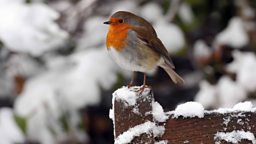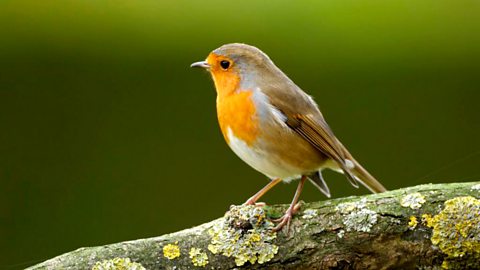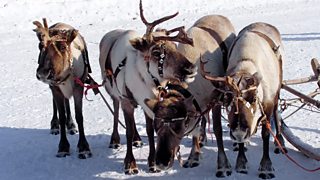Eight reasons why we love robins
Author and naturalist Mark Cocker explores the reasons for our love affair with the quintessential bird of Christmas.
-
![]()
Tweet of the Day: Robin
Brett Westwood presents the story and sound of the robin.
1. It’s our robin
Few wild British creatures are more beloved by the British than the robin. And there is good reason for us to think of our bird as special: it is actually a separate subspecies.
The robin’s European counterpart is a shy woodland-dwelling introvert, while our robin is the classic bold suburbanite, which will feed on the bird table, sing from the handle of a garden fork and nest in a plant pot in the shed.
2. A small flame in a cold season
It may seem obvious but the red on robins is the most magical colour in nature and with a heart rate of 1000 beats a minute, there is genuine fire in that small puff of bright feathers.
Robins are one of the 2-3 birds that routinely sing throughout winter. The British subspecies is even called melophilus, meaning “the song-loving” robin.

3. A friendly name
The robin is one of the few birds in the English language with a human name. Robin is really a contraction and diminutive of “Robert”. The original word for the species was “Ruddock” or “redbreast”. Over time this was personalised with a Christian name as a mark of respect for its aura of friendship.
There were many historical taboos against harming robins, such as the belief that killing one would cause your cows to produce bloody milk. Children once thought that if they took eggs from a robin’s nest they would develop bent fingers.
4. A good honest church-going bird
Robins are among our most ecclesiastical of birds. There are stories linking them to St Serf of Culross as long ago as the 6th century AD. It was believed that the species acquired its red breast when it tried to pull thorns out of Christ's crown during the Passion and became stained with his blood.
There have been regular examples of robins nesting inside religious buildings. In the reign of Charles II, one routinely sang from Canterbury Cathedral, while a particularly pious Bristol bird lived in the cathedral for years during the 19th century.
5. On every mantelpiece at Christmas
The robin’s associations with Christ and Christmas were reinforced in the 19th century when the newly created postal service dressed its delivery staff in red uniforms. The workers became known as “Robins” and when Christmas cards were popularised in the 1860s they were often illustrated with the postman’s avian namesake. Today robins have a permanent perch on the modern Christmas mantelpiece.

Why robins sing
It may sound melancholy to us but the robin's call has a clear purpose in autumn.
6. The new nightingale
In R.D. Blackmore’s classic novel, Lorna Doone, the author suggested that “Everyone knows that robins sing all night.” If anything, the nocturnal performances have only increased with the advent of street lighting, even in places like central London. City dwellers sometimes mistake such night-time melodies as the work of an even more famous songster, the nightingale. Some question whether the popular 1940s song “A Nightingale sang in Berkeley Square” hinges on similarly faulty identification.
7. Wherever I lay my hat…
Robins are famously unfussy when it comes to building their nests. The plant pot in the shed is the stock cliché, but robins have been known to build in peg bags, abandoned kettles, rolls of wire, on a bedroom pelmet, in an unmade bed, in the pigeon hole of a desk, between the teeth of a corpse swinging on a gibbet, in the pocket of a gardener's jacket, under the bonnet of a sports car, in the engine to a fighter plane and in the hole made by cannon fire in the mast on which Nelson was leaning when he received his fatal wound.
8. Spreading the bird
In 2015, the robin was officially chosen as our national bird but its status as a kind of living flag is much older. Our ancestors tried to introduce robins into many parts of the empire, including the USA, Canada, Australia and New Zealand. While these introductions all ended in failure, we did name many other birds after the robin. Today there are species all over the world, some not even remotely related to the real thing, called “Indian robin”, “American robin”, “Pekin robin” and “Cape robin”.




